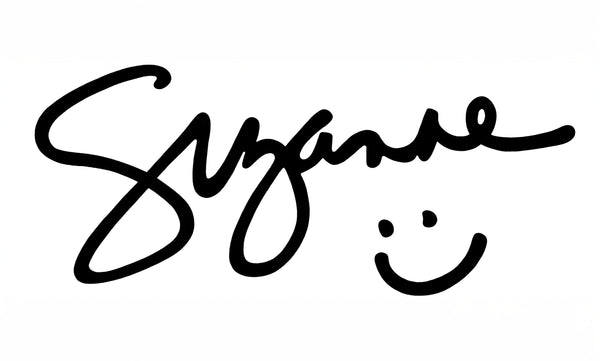prep before the paintbrush hits the surface
Share
In the interest of being helpful and transparent, here is a portion of my painting prep documentation. Whenever I look at this document (saved in my google docs) I am reminded of how much expertise and patience it takes to make a fully realized series of paintings.
Painting Process and Workflow
Initial sketches—made using collage, drawing, watercolor—often up to or exceeding 100 studies for a project of 30 paintings
Decide: on the number of paintings in the series (typically (9-30±). Realize this number may change.
This means eliminating some of the studies that do not fit the aesthetic or theme.
Below is the finished piece from the above study. ©2019, Suzanne Gibbs, Purple Lipped Confusion, Bristol paper, Flashe paint, Posca Pen, on cradled wood panel, 24 x 24 inches.
Order Supplies
Wood panels (size and shape dependent on series and intent)
Blue tape, 1 inch and 2.0 inch
Gesso (gallon bucket)
Brushes (various sizes, discard used ones)
Matte Medium (used as glue)
Paint-Flashe (or other)
Jars to mix paint colors
Bristol paper and/or watercolor paper (various uses)
X-acto knives and blades
Cutting mat
Straight edge
Canvas and/or fabric (swatches as needed for added texture)
Spray bottle filled with water
Brush cleaner
Paper towels
Rags and towels
Porcelain dishes (for mixing small amounts of color)
Swedish sponge (keeps brushes wet between uses)
Make collage pieces (these are currently made using a straight-edge and X-acto or scissors)
½ inch
1 inch
1.5 inch
2 inch
Future: circles, rectangles, and organic shapes
Typically these are made with paper, both scraps and new bristol paper (newsprint and light weight paper buckles too much and should be avoided)
Occasionally old art is cut up and used
Sometimes old canvas paintings have been cut up or left-over canvas without paint
Prep Panels
Add wire to the painting before beginning the work
Add logo and website stamp
Add inventory number (sometimes done after piece is completed)
Seal edges with wood sealant or matte medium (2-3 coats)
Wait for edges to dry, 1-2 days
All edges get taped, including the back surface (to keep customer walls clean and free of possible scratches from "extra paint" on the backs of works)
2-4 layers of gesso, gently sanded between each layer (sometimes no gesso)
Collage layer—at times it is necessary to draw lines of a grid to ensure that the collage grid is properly placed and adhered, a grid 3x bigger than the smallest square size can be successfully used as the underlying structure
Extra layer or 2 of gesso (depending on the color of paper used to collage)
Sometimes a tinted gesso is required depending on the plan for the work
Make sure gesso covers the edges of the panel up to the tape
Using an enlarging projector or another scaling technique (grid system) draw the image to be painted on large paper and transfer with graphite coat and pen or directly onto the prepared panel
Begin the “recipe” page, color ideas, concept, notes, and inventory number
Begin painting.










